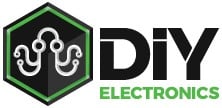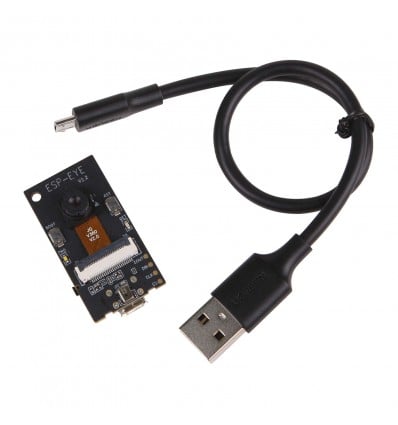International shipping Secure payment
No products
Prices are tax included
Product successfully added to your shopping cart
There are 0 items in your cart. There is 1 item in your cart.
The ESP-EYE is an all-in-one ESP32 dev board equipped with an onboard camera, microphone and AI software for a nearly Plug-n-Play “AIoT” experience.
3 Items
Warning: Last items in stock!
Free shipping on orders over R1250 - courier delivery and within South Africa
With the growing popularity of AI and the leaps and strides that are being made in terms of making it smarter, more compact and more user friendly, it comes as no surprise that Espressif are getting in on the action with their own awesome “AIoT” development platform – cleverly named the ESP-EYE.
The ESP-EYE is an Image Recognition and Audio Signal Processing Development Board that comes as an all-inclusive package, with a built in camera and microphone, as well as onboard AI software that utilises the ESP-WHO AI frameworks and ESP-IDF software SDK, so as to give Makers an awesome new tool to experience and explore artificial intelligence technology in the world of IoT or Internet of Things.
In addition to offering pretty much all of the great features that are typically found on ES32-based Dev Platforms, such as built-in WiFi and Bluetooth communications and an easy-to-use development environment, the ESP-EYE takes AIoT to a new level by incorporating all of the typical peripherals required for AIoT, and putting them onto one board. This not only makes it more affordable and easier to use for end-users, but also ensures that every part is perfectly compatible from the very start, which means that you can simply focus on what’s important to you as a developer – actually developing the software and system, without having to fiddle with hardware.
Please Note: Although we found it quite humorous, we know that it may be frustrating for others: When you first setup and calibrate this board for audio signalling, it will tell you to say the words “Hi Lexin”. When faced with this prompt, you actually have to say something that is closer to “Hi Layshin” or “Hi Lehshin”, which of course is simply due to the “Chinglish” translation from Espressif.
ESP-EYE: AI Image / Audio Processing Dev’ Board - Technical Specifications: |
|
|
– 5V DC (USB) |
|
– 3.3V DC |
|
– 0.5A |
|
– 1.2A |
|
– ESP32 |
|
– Micro USB |
|
– 2 Megapixel |
|
– Onboard Digital Mic |
|
– 8MB |
|
– 4MB |
|
– Raspberry Pi | Windows |
|
– Front: BOOT Button | Reset Button – Side: Function Key |
|
– Red LED + White LED |
|
– Reserved Port for Data Transmission |
|
– Included |
|
– -40° to +150°C |
|
– 41 x 21 x 6.5mm |
Typical Applications for the ESP-EYE Development Board:
With the ESP-EYE being comprised of a full ESP32 based development board, alongside a range of awesome built-in peripherals and a development environment that is a true pleasure to work with, it seems obvious that this board is more than just capable of handling a few projects. In fact, because of the unique aspects of this board, and the way that it can detect and recognise faces as well as voices, it is natively much more capable than any of its predecessors.
So, in an attempt to show you just how awesome this ESP-EYE Image/Audio Recognition Development Board is, we’ve been exploring the following project ideas, which have been designed specifically with the ESP-EYE in mind:
- Creating your own employee tracking system, which identifies each employee by their face, requests confirmation by voice command, and sends all of that data to a central database for logging and later review.
- Developing store-front marketing material that identifies repeat customers and offers them their favourite meals, drinks or types of clothes according to past purchases. This could also keep track of how often specific guests visit the store, as well as how many strangers walk by each day – of course, sending all of this data via an IoT network to be used for further marketing purposes too!
- Building a robot that can actually identify its owner, perhaps following you around the airport with your luggage in tow, or flying after you as an experimental drone-buddy – ready to take selfies via voice command or play fetch with its favourite bright red ball.
Of course, the above examples are just to demonstrate the diverse capabilities of this board, and if you have any other ideas of how to use the ESP-EYE, we always encourage you to explore those ideas and if you share those projects on social media, be sure to tag us! We love to see all of the awesome ideas that you fantastic Makers come up with from time to time, and we look forward to seeing just what you can with the low-cost, high-coolness ESP-EYE development platform!
Additional Resources:
- This is a great ESP-EYE “Getting Started Guide” from Acoptex, which covers some basic details of the board and onboard peripherals, while giving some great insights on how to connect with and utilise the board effectively.
- This is the official Espressif ESP-WHO GitHub Page, containing documentation, insights and examples for the ESP-WHO Framework, as well as how it operates with the ESP-EYE and ESP-WROVER.
- This is the official Espressif ESP-EYE Resources Page, with a getting started guide, reference design documentation and links to further resources if necessary.
- Additionally, this DFRobot ESP-EYE Wiki Page offers a wealth of information on how to connect your new ESP-EYE to a Windows computer or Raspberry Pi, and how to get started with your first ESP-EYE based project.
Finally, this is a great ESP-EYE First Look Review, which takes you through the receiving, unboxing and first use this awesome board, as well as what you can expect when you get yours:
No customer reviews for the moment.
As self-proclaimed “Robo-holics”, DFRobot is a company comprised of over 100 staff members, of which 30% are engineers who love to build robots. It was started in 2008 with the goal of embracing and promoting open-source hardware, with a core focus on Arduino, Raspberry Pi and their very own LattePanda development boards. Since then, DFRobot have manufactured over 1300 unique modules, sensors and components that all work together and complement each other, allowing users like us to enjoy a full spectrum of cutting edge robotics and electronics without having to pay premium prices.
With the primary goal of developing and manufacturing great quality products, while making them accessible to as many people as possible, DFRobot are rapidly becoming one of the most common-place brands in the world of open-source robotics and electronics. With more than 1300 products developed in-house, and an impressive range of different categories and specialisations, there are few brands in the world who can compete in terms of quality, accessibility and genuine innovation.







